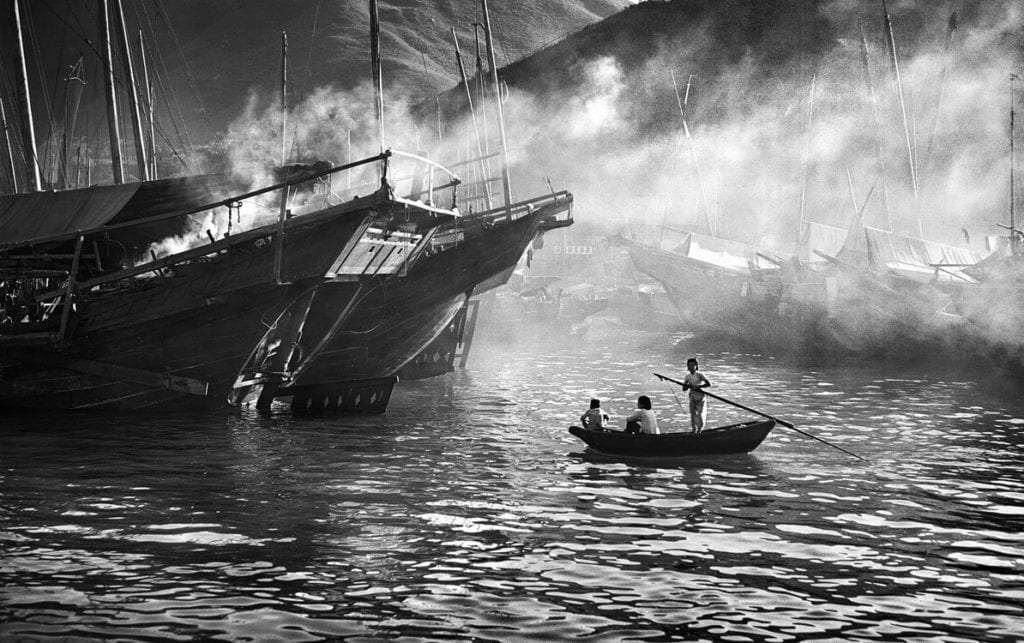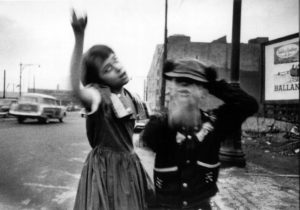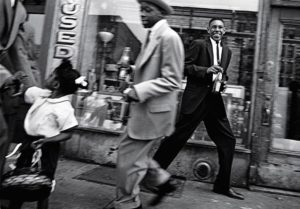
I first came across Fan Ho’s work in a podcast from Ted Forbes‘ The Art of Photography. Some photographer’s work gives me an immediate jolt the first time I see it. Fan Ho’s photography, like that of Brassaï and William Klein, to name just a couple of others, gave me that same instant reaction. His painterly use of smoke, mist, light and shadow combined with incredible, often geometric, composition is breathtaking. An blog post on Kept Light refers to some Ho’s photographs of boats on the water as being “reminiscent of Turner’s paintings with light emanating from the work.”
His mastery of street photography has led to him being referred to as the ‘Henri Cartier-Bresson of the East,’ but I much prefer his nickname ‘the Great Master’. The influence of the European composition tradition is clearly present, but his vision is unique. Transplanted to the East, his unique blend of light and geometry that somehow combines drama with serenity has made him one of the world’s greatest photographers. As Abigail Cain put it in an article on Artsy at the time of his time of his death in 2016:
The serene and contemplative nature of Ho’s work is particularly remarkable considering the tumultuous state of Hong Kong during his most prolific decades. The artist and his family were among the many hundreds of thousands of refugees that flowed into the city in the 1950s, fleeing the reignited Nationalist-Communist Civil War that was ravaging mainland China. Between 1945 and 1951, the city’s population more than doubled. However, Ho’s photographs reveal nothing of that chaotic historical context; instead, they present timeless scenes of life in Hong Kong. The marriage of old and new—a traditional Chinese sailing vessel bobbing alongside a battleship in the harbor, a wooden rickshaw being pulled across steel train tracks—was a consistent feature of his work, as was a fascination with the natural geometry of urban alleyways and markets. And now, when the city ranks among the most densely populated locations in the world, Ho’s reflective photographs offer an experience unattainable anywhere else—solitude on a Hong Kong street
In a similar vein, Laurence Miller, a Manhattan gallery owner, described Fan Ho’s photographs as “like direct descendants of the Bauhaus, yet they were made in Hong Kong. They were abstract and humanistic at the same time.”
Street Photography
Fan Ho was born in Shanghai in 1931, and emigrated with his family to Hong Kong in 1948. He took up photography at a very young age and adopted the Rolleiflex he would use for the rest of his career at the age of 14. Living in the Central neighbourhood of Hong Kong, he was in the perfect position to document street life, though at a time when studio photography was far more common than street photography. An article I found at a site called the Red List (the link is no longer valid) describes what Fan Ho found and captured in the Hong Kong in the late 1940s and early 1950s:
The centre of a chaotic atmosphere, the city had received the thousands of refugees of Japan’s invasion and thus was marked by despair, poverty and tumult. Yet, the photographer managed to capture an almost empty city, concentrating on individual subjects and scenes whose theatricality were enhanced by his dramatic use of light, shadow and smoke within geometric compositions – no wonder one of his series was entitled Living Theatre. With his black and white images, Fan Ho illustrated a nostalgic and melancholic cinematic Hong Kong where traces of modern life and issues disappeared behind traditional lifestyles as if reality had been erased: ‘I liked to concentrate and simplify the world in black and white, it was more suitable to my nature. I could express my emotions more freely, they were more fully under my control, [and the results were] surreal and semi-abstract. I liked this distance: not too close, not too far away…’ With his reclusive photographs, Fan Ho offered a seductive fantasy to Hong Kong’s inhabitants, that of loneliness.
Fan Ho’s creative process required a great deal of patience, no least because Hong Kong was and remains one of the most densely populated places on earth, but also to get all the other elements he needed to be in place. He described how he worked to the Independent in 2014:
At the beginning you must find the ideal location. Then you must be patient to find the right subject that arouses your interest, even if it’s just a cat . You must have the precise moment to catch the spirit, the essence, the soul of the person… If you don’t have the exact moment, you have to wait for the right feeling. It’s real creative work because you have to have the feeling inside.
Ho was critically acclaimed: a fellow of the most prestigious photographic societies, he was named one of the “Top Ten Photographers of the World” by the Photographic Society of America between 1958 and 1965. He was also an Honorary Member of the Photographic Societies of many countries around the world. He simultaneously pursued a career in film, starting out with the Shaw Brothers and later becoming a film director. Ho died in 2016, in San Jose, California at the age of 84. His images of Hong Kong remain the most iconic images of the city and his photography continues to be on show in major museums around the world.

